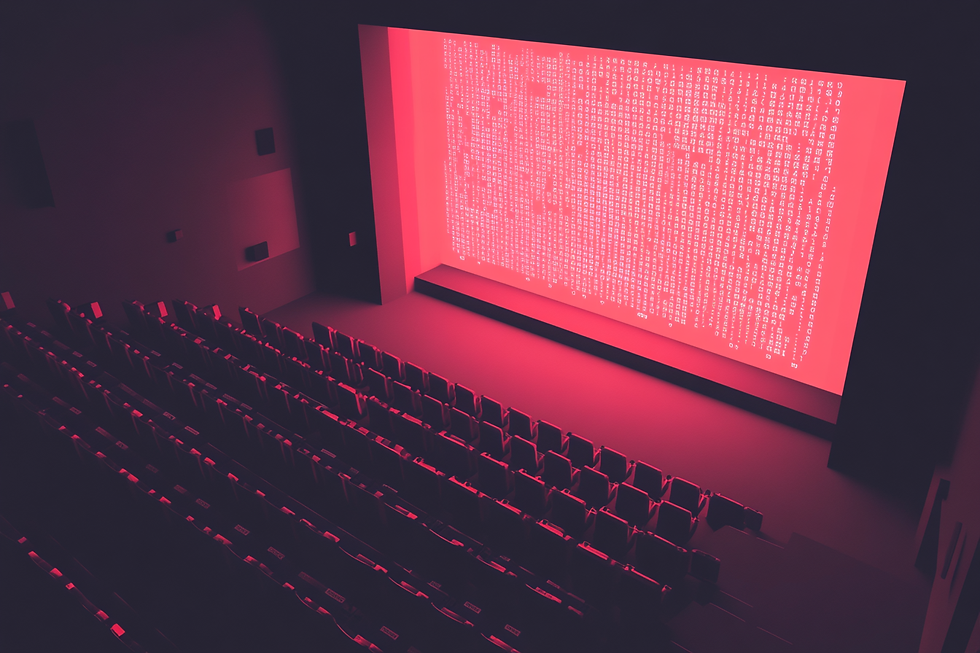AI Inside: Demystifying Digital Transformation in Physical Spaces
- James Garner
- May 23
- 8 min read
Updated: May 30

The digital transformation of physical environments represents one of the most significant yet underappreciated revolutions happening today. We recently had the pleasure of hosting David Blumenfeld, co-founder of Next Rivet and Core Rivet, on the Project Flux podcast - you can listen to the whole episode here. With his extensive experience in bringing digital experiences to physical shopping environments and beyond, David offered invaluable insights into how traditional industries can navigate the rapidly evolving landscape of AI and digital transformation.
As someone who has been at the forefront of digital innovation in retail spaces since his time at Westfield Labs, David brings a unique perspective that balances technological enthusiasm with practical implementation strategies. His thoughts on everything from AI education to the future of guest experiences paint a compelling picture of what's possible when digital and physical worlds converge effectively.

The "AI Inside" Mindset: Demystifying Artificial Intelligence
One of the most striking aspects of our conversation with David was his approach to demystifying AI for traditional industries. Rather than presenting AI as a revolutionary new technology that companies need to adopt wholesale, he frames it as an evolutionary enhancement to existing systems.
"We've just evolved to now AI inside," David explained, drawing a parallel to Intel's famous marketing campaign. "I think people have to remember it's an ingredient. It's not a standalone thing in most cases."
This "AI inside" perspective helps executives understand that they don't need to comprehend an entirely new technology. Instead, they can focus on how AI enhances capabilities they already use. David points to early recommendation engines as examples of AI that have been around for years: "If you use Amazon or an online shopping service and the first time you bought something and then you got a recommendation for something else you should buy. That was an early form of AI."
This framing helps demystify what can otherwise seem overwhelming, especially for industries that aren't traditionally tech-forward. By understanding AI as an ingredient rather than a standalone solution, companies can more easily envision how it fits into their existing operations.
The Education Gap: Why Traditional Industries Struggle with AI
Despite AI's growing ubiquity, David observes a significant education gap in traditional industries like real estate. This gap manifests in various ways, from outright resistance to misguided implementation attempts.
"We've seen legal teams who have prevented their entire organisation from using something like ChatGPT," David noted. "They've just kind of put a blanket 'we're not using AI' policy across their company because they're fearful that because they don't understand it."
This fear often stems from misconceptions about data security and privacy. While David acknowledges legitimate concerns about uploading sensitive financial information to public AI platforms, he emphasizes that there are secure ways to leverage AI technology: "There are obviously ways to do that in a walled garden fashion where you can leverage this technology on your own servers, not just putting it out there on the broader internet."
Bridging this education gap has become a core focus for David and his team at Core Rivet: "We're really focused on this year, which is how can we get in there and start to educate these executive teams on exactly what AI is." Through speaking engagements and direct client education, they're working to ensure companies can take advantage of AI's benefits without being overwhelmed by its complexity.
Getting Started: The Agile Approach to Digital Transformation
When advising executive teams on AI strategies, David emphasises the importance of starting small and being agile—a stark contrast to the long-term planning typical in real estate development.
"The important thing is to get started. You don't need to have a three-year plan out of the gate," David advised. This approach acknowledges the fundamental difference between physical and digital development timelines. While building or remodeling a shopping center requires years of planning for architecture, design, construction, and leasing, technology implementation can and should be more iterative.
David highlighted this contrast: "When you think about something like traditional real estate... there's a lot of long-term planning that goes into that. The beauty of technology, obviously, is you can do it and you can also fail and fail fast and learn and try new things."
This agile mindset represents a significant cultural shift for traditional industries accustomed to predictable, long-term returns on investment. As David put it: "You put up a wall in a shopping center that's not to code or is falling over and you have to replace that wall... that's a lot of time, money and effort. You can't afford to make mistakes like that." Digital transformation, by contrast, allows for experimentation and iteration without the same level of risk.
The key takeaway? Start with a couple of initiatives, learn from them, and build from there: "Don't try to boil the ocean to do everything right now. But if you don't get started, you're never going to be able to get to the point where you can start to think about a one year, two year, three year roadmap."
Beyond Consumer-Facing Tech: The B2B Revolution
A common misconception about digital transformation in real estate is that it's primarily about consumer-facing technology. While David acknowledges the importance of enhancing customer experiences, he's particularly excited about the business-to-business applications that are transforming operations behind the scenes.
"Maybe the misconception is it's not just consumer or B2C," David explained. "Where I get excited are some of the business to business aspects, things like building management systems or video analytics."
These technologies are creating entirely new data sets that were previously unavailable. For example, video analytics can now track not just how many people enter a shopping center, but where they go once inside: "If 100 people walk by a certain store, 10 of those people went inside that store. Now I can have real conversations with a tenant if they feel like, 'Wow, my sales are down and the mall is not doing their job getting people to my door.'"
This data-driven approach transforms conversations that were previously based on estimates and assumptions. As David put it: "We're using real data now, we're not using estimates." This extends to operational efficiencies as well, such as scheduling bathroom cleaning based on actual usage patterns rather than arbitrary time intervals.
One of David's favorite examples of successful digital transformation is the "frictionless parking" system first implemented at Westfield London: "It was license plate recognition tied to your credit card, tied to your own account. So when you drive up to that boom gate, the boom gate automatically opens, you drive in and then depending how long you stay, you drive up to the boom gate on the way out. It opens up, it charges your card."
This seemingly simple enhancement dramatically improves the customer experience at what David calls "the first and last touch point with that visitor"—making them happy on arrival and departure.
The Critical Thinking Challenge
Looking beyond immediate implementation challenges, David raised thought-provoking concerns about the long-term implications of AI adoption, particularly regarding critical thinking skills.
"My concern over time in 10, 20 years is the critical thinking aspect," he reflected. "The people who have come up with all these tools at their fingertips, are they gonna have the same critical thinking skills that the people who didn't come up with have today?"
This question highlights the evolving relationship between humans and technology. Currently, experienced professionals use AI tools to organize information or generate initial drafts, but still apply their judgment to evaluate and refine the output. As David explained: "That just helped me maybe think about and organize a framework more quickly, but I'm still using my own thought to decide whether or not what I should include, what I shouldn't, is this really answering it the right way."
The concern is that future generations might rely more heavily on AI recommendations without developing the same depth of experience-based judgment. This could shift the dynamic from "human oversight of technology" to "technology with humans just kind of fulfilling certain roles within that."
While David acknowledges this might be an unfair assessment—"who knows what's going to come out in the next 20 years that maybe up levels the human game as well"—it represents an important consideration as we integrate AI more deeply into business processes.
Future-Proofing in a Rapidly Evolving Landscape
When Yoshi asked how David ensures his advice stands the test of time given AI's rapid evolution, David responded with characteristic candor: "Yoshi, stop asking these questions that I can't answer!" After the laughter subsided, he addressed the fundamental challenge of future-proofing in today's environment.
"All of our clients are hoping for a future proof," David acknowledged. "But that's also why you don't build a five or 10 year roadmap." Instead, he recommends focusing on foundational elements that enable future flexibility: "You do need to plan some foundational piece, just like you're building foundations of a building, physical building. You need to put in some foundations from a technology perspective."
These foundations create the infrastructure upon which more agile, responsive systems can be built. However, even these foundational elements must be approached with flexibility: "The reality is putting the foundations in and then knowing even in that early stages, like things may change. Like we may have to adjust this. This isn't a roadmap that's set in stone."
This approach represents a significant shift for traditional real estate companies accustomed to long-term planning with predictable outcomes. As James noted, "Tech companies are quite good at that kind of agile approach. I feel sometimes like real estate companies and construction companies, they struggle a bit more with being agile. They like a plan and they like to stick to the plan."
The solution, according to David, is a mindset change that embraces uncertainty and continuous adaptation—a challenging proposition for industries with decades-long planning horizons and employees who have "worked there for 20, 30 years."
Cross-Industry Applications: From Retail to Healthcare
While David's expertise is primarily in retail and real estate, our conversation explored how the principles of digital transformation in physical spaces apply across industries. The common thread? Enhancing the guest experience through thoughtful digital integration.
"If you think about the side of the house that we work on in the real estate space, the shopping center space, which is about the guest experience... that applies to guest experiences and hospitality more broadly," David explained.
This perspective has led Next Rivet to explore projects in diverse settings, from mixed-use developments that combine retail, residential, and office spaces to sports venues and even healthcare facilities. In each case, the focus remains on using digital tools to enhance physical experiences.
In the hospital context, for example, David's team has been asked to consider: "What's the guest experience at a hospital? And not just the patient but like what is the family experience? Like you're going in, you're sitting there... you may be in a waiting room for a long period of time. How do you make that environment more pleasant?"
This cross-industry application demonstrates the universality of digital transformation principles. Whether in a shopping mall, a sports stadium, or a hospital waiting room, the goal remains the same: using digital tools to create better, more responsive physical environments.
Navigating the Digital Transformation Journey
Our conversation with David Blumenfeld revealed a nuanced picture of digital transformation in physical spaces—neither a simple technology upgrade nor a complete reinvention, but rather a thoughtful integration that respects both the possibilities of digital innovation and the realities of physical environments.
The key insights for executives in traditional industries are clear: educate yourself about AI's capabilities and limitations, start small with focused initiatives rather than comprehensive plans, build flexible foundations that can evolve over time, look beyond consumer-facing applications to operational enhancements, and maintain a balance between technological assistance and human judgment.
As physical and digital worlds continue to converge, the organizations that thrive will be those that can navigate this intersection effectively—understanding that digital transformation isn't about technology for technology's sake, but about creating better experiences and more efficient operations in the physical spaces where we live, work, and shop.
Connect with David Blumenfeld on LinkedIn to follow his insights on digital transformation in physical spaces. Learn more about his companies at NextRivet.com and CoreRivet.com.
And as always, subscribe to the Project Flux newsletter for weekly updates on how technology is transforming the future of projects.



Comments